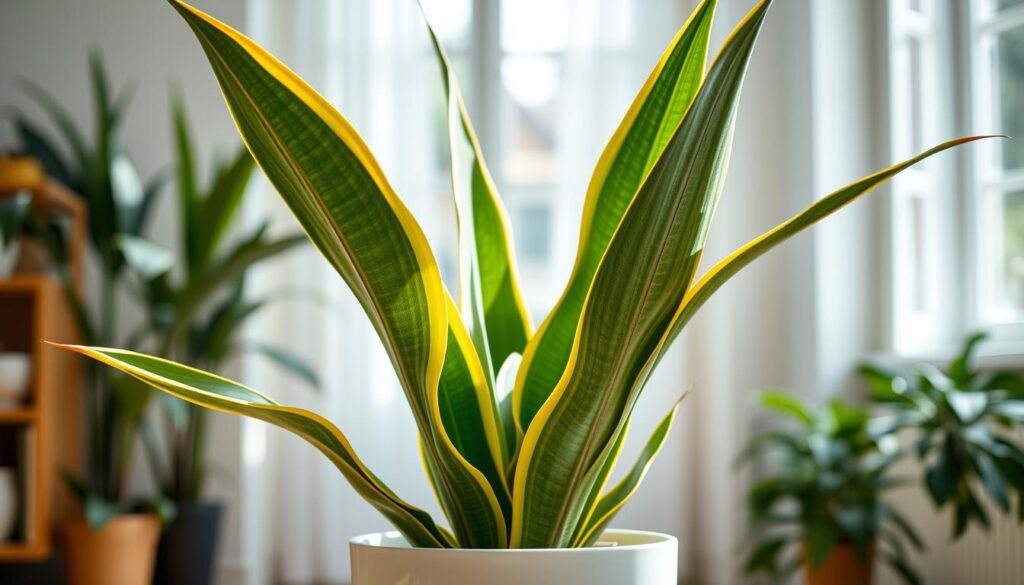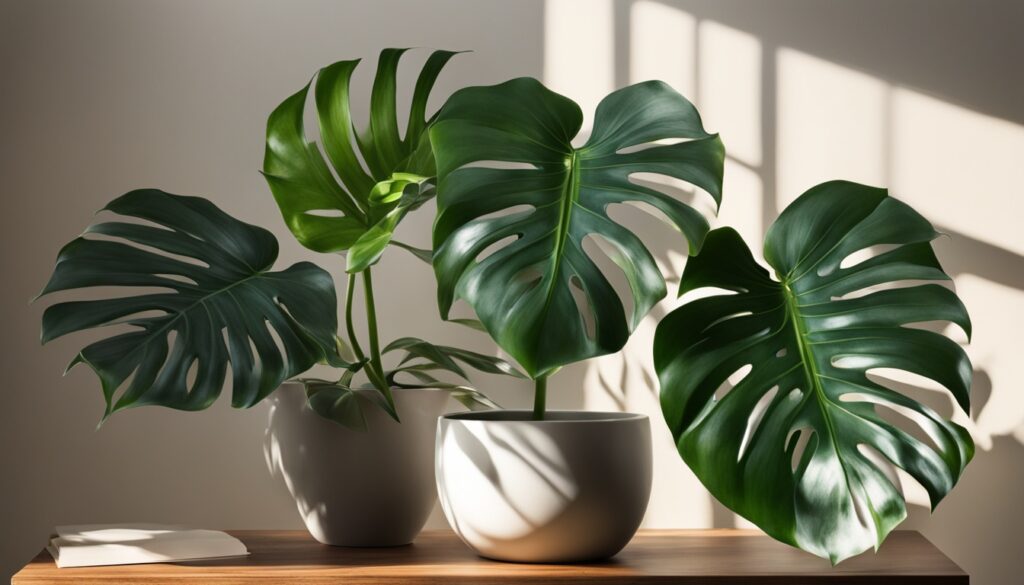Do you own a snake plant, also known as a Sansevieria, and wonder how often you should water it? These hardy, drought-tolerant houseplants are known for their resilience. But, proper watering is still crucial for their long-term health and growth. How do you know when to water your snake plant, and what factors influence the watering schedule?
Key Takeaways
- Water snake plants every two weeks or when the top two inches of soil are dry.
- Adjust watering frequency based on season, light exposure, and plant size.
- Avoid overwatering as it can lead to root rot and other problems.
- Use well-draining soil and avoid letting the plant sit in standing water.
- Monitor for signs of under- or overwatering to maintain optimal plant health.
Understanding Snake Plants: A Hardy Succulent Species
The sansevieria trifasciata, also known as the “mother-in-law’s tongue” or “viper’s bowstring hemp,” is a popular succulent. It’s loved by both new and experienced gardeners. These plants come from Africa and Southern Asia and can handle tough weather.
Native Origins and Natural Habitat
The snake plant comes from hot, dry places. It can survive long without water and strong sunlight. Its thick leaves store water, helping it keep moisture and photosynthesize differently.
Common Names and Varieties
The sansevieria trifasciata is also called “tiger’s tail orchids.” It has many varieties, each unique. You can find the tall “Zey,” the small “Mikey,” the rare “Apollo,” and the flexible “Susie.”
Basic Characteristics
The sansevieria trifasciata has long, sword-like leaves. They grow slowly indoors but can get very tall. They can be as short as 8 inches or as tall as 9 feet.
Why Snake Plants Are Perfect Low-Maintenance Houseplants
Snake plants, also known as sansevieria or mother-in-law’s tongue, are perfect for those who don’t have time to care for plants. These drought-tolerant houseplants can survive with little water and light. They are great for anyone, even if you’re new to plant care.
Snake plants grow slowly, which means they don’t need constant attention. They can go weeks without water and still look good. This makes them easy to care for, perfect for busy people or those who forget to water their plants.
“Snake plants are nearly indestructible and can handle a wide range of environments, from bright sunlight to low-light conditions.”
These plants are also very hardy. They come from Africa and can handle different environments. As long as they have good soil and some sunlight, they’ll do well with little care.
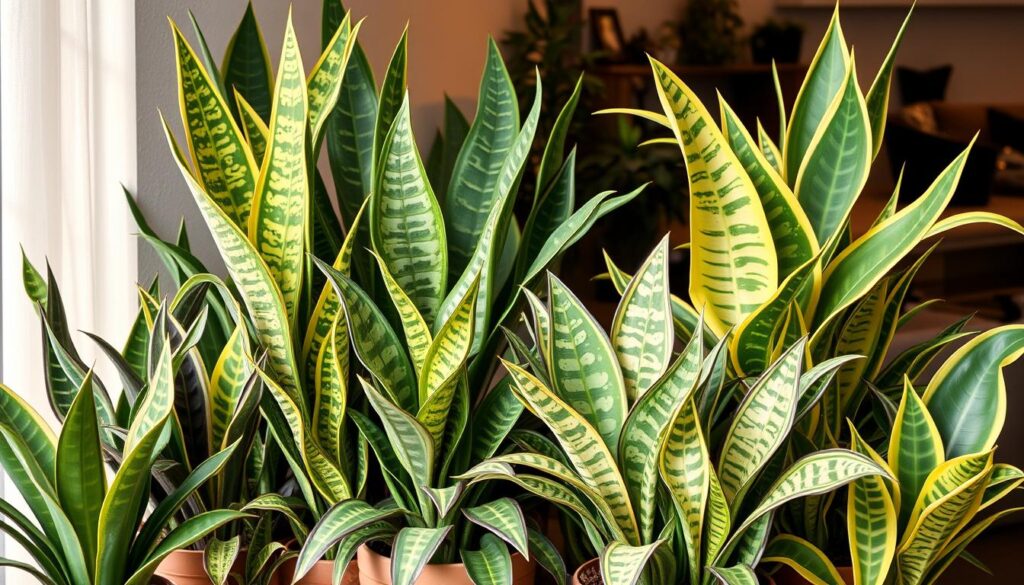
Snake plants come in many sizes and colors, adding beauty to any room. You can find tall plants or small ones, in different colors. This makes them great for adding style to your space without much work.
In short, snake plants are perfect for those who want easy-to-care-for plants. They are adaptable, grow slowly, and are very hardy. They make great companions for any home or office, requiring very little care.
How Often Should You Water Snake Plant
Watering your snake plant right is key to its health and growth. These plants do well with a watering plan that fits their needs. This plan changes with the seasons and where you grow them.
Seasonal Watering Requirements
In spring and summer, snake plants grow fast and need water more often. Water them once a week during these months. But in fall and winter, when they’re dormant, water them every two to three weeks.
Indoor vs Outdoor Watering Needs
Indoor snake plants need less water than those outside. This is because indoor plants get less sunlight and cooler temperatures. So, the soil dries out slower.
Climate Impact on Watering Schedule
The weather where you live affects how often to water your snake plant. If it’s always over 55°F, stick to the seasonal watering schedule. But in cooler, wetter places, your plant might need even less water.
Watching the soil moisture is crucial for your snake plant’s health. Knowing how the seasons, environment, and climate affect its water needs helps it thrive for years.
Factors Affecting Snake Plant Water Requirements
As a succulent plant, snake plants need different amounts of water based on their environment. Knowing these factors is key to keeping these arid climate houseplants healthy and vibrant.
The amount of light a snake plant gets affects how often it needs water. Plants in bright, indirect light need more water than those in dimmer spots. Temperature and humidity also matter, with warmer, drier places needing more water.
| Factor | Impact on Watering Needs |
|---|---|
| Light Exposure | Bright, indirect light = More frequent watering Low light = Less frequent watering |
| Temperature | Warmer temperatures = More frequent watering Cooler temperatures = Less frequent watering |
| Humidity | Low humidity = More frequent watering High humidity = Less frequent watering |
| Soil Type | Well-draining, porous soil = Less frequent watering Dense, heavy soil = More frequent watering |
| Pot Material | Terra-cotta = Faster drying, more frequent watering Plastic = Slower drying, less frequent watering |
By taking these factors into account, you can create a watering schedule that works best for your arid climate houseplant. Check the soil moisture and your plant’s look often. This will help you adjust your watering to keep your plant happy and healthy.
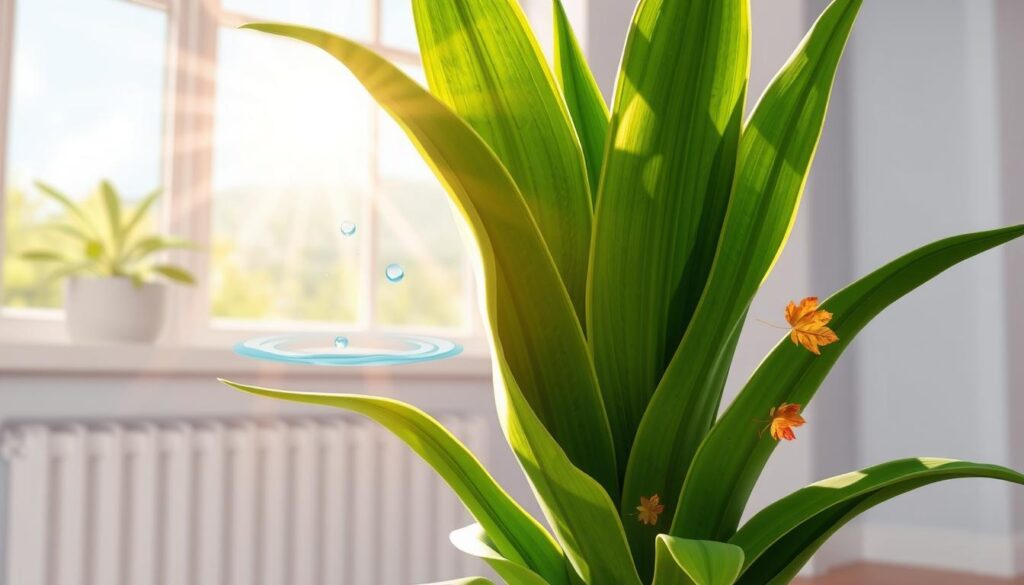
“Nearly 80% of houseplant owners fail to properly water their plants, a figure that includes snake plant owners.”
Light Conditions and Their Impact on Watering
Watering your snake plant depends a lot on the light it gets. Plants in bright, direct light need more water than those in dimmer spots. Knowing how light affects water needs helps keep your indoor plant healthy and looking good.
Bright Light vs. Low Light Environments
Snake plants in sunny areas need more water to grow well. They might need watering every 10-14 days when it’s growing. But, plants in shady spots, like corners, need water only once a month or every six weeks.
Adjusting Water Based on Light Exposure
Watching the soil moisture is key to caring for snake plants. If leaves start to droop or turn yellow, it’s time for more water. But, if the soil stays wet too long, you might be watering too much. This can cause root rot. Finding the right balance between light and water keeps your low-maintenance plant happy and healthy.
| Light Conditions | Watering Frequency |
|---|---|
| Bright, Direct Light | Every 10-14 days |
| Low Light | Every 4-6 weeks |
“By understanding the relationship between light and water needs, you can effectively maintain the health and vibrant appearance of your indoor plant.”
Temperature and Humidity Considerations
When caring for your arid climate houseplant, like the snake plant, knowing the best temperature and humidity is key. These drought-tolerant houseplant care factors affect how often you need to water your plant.
Snake plants love warm temperatures, best above 10°C (50°F). Warmer temps mean more water, while cooler temps mean less. Keep your snake plant away from drafts, especially in winter, to keep it healthy.
Humidity also matters for your snake plant’s watering needs. These plants like it dry and should stay out of humid places like bathrooms. Adjust your watering based on temperature and humidity changes to keep your plant just right.
| Temperature Range | Humidity Preference | Watering Frequency |
|---|---|---|
| Above 10°C (50°F) | Dry conditions | Every 1-2 weeks, allowing soil to dry out completely |
| Cooler temperatures | Avoid high-humidity areas | Reduce watering to once a month during winter |
| Higher temperatures | Increase watering frequency if soil is very dry | Increase watering during summer months |
Knowing your arid climate houseplant‘s temperature and humidity needs helps you care for it better. This way, your snake plant will stay healthy and stand tall.
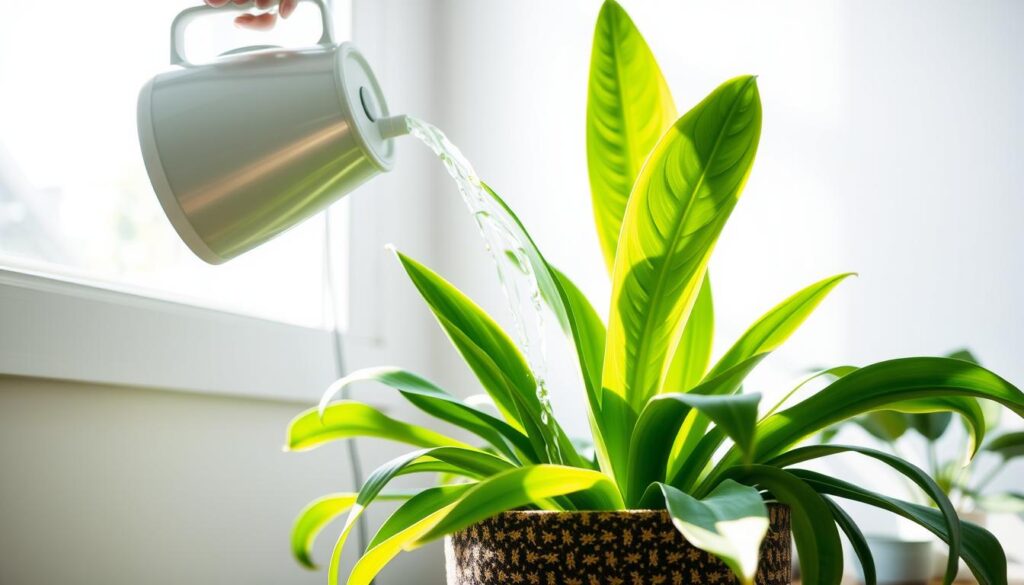
“Proper watering is crucial for maintaining the health and vigor of your snake plant. Adjust your watering schedule based on the plant’s environmental conditions to ensure optimal growth.”
Proper Soil and Drainage Requirements
For successful snake plant cultivation, choosing the right soil and ensuring proper drainage are essential. Snake plants, being succulents, thrive in sandy, well-draining potting mixes that mimic their native arid environments.
Best Soil Types for Snake Plants
The ideal soil for snake plants is a blend of potting soil and succulent-specific compost. This combination provides the necessary nutrients while allowing for excellent drainage. Specialist houseplant or cactus compost mixes are excellent choices, as they are formulated to meet the specific needs of these types of low-maintenance plant water requirements.
If using a general potting soil, it’s recommended to mix in sand or perlite to improve the soil’s drainage properties. This simple modification helps prevent the accumulation of excess moisture, which can lead to root rot and other issues commonly associated with succulent plant watering tips.
Importance of Well-Draining Potting Mix
Proper drainage is crucial for the health and longevity of snake plants. These hardy succulents are susceptible to root rot if the soil remains waterlogged for extended periods. Well-draining potting mix allows excess moisture to quickly escape, ensuring the roots have access to the necessary air circulation and preventing the development of fungal diseases.
| Soil Characteristic | Ideal Composition |
|---|---|
| Texture | Sandy, gritty |
| Drainage | Excellent, fast-draining |
| pH Range | 6.0 – 7.5 |
By providing snake plants with the right soil and drainage conditions, gardeners can create an optimal environment for their long-term growth and succulent plant watering tips. This attention to detail helps ensure the plants thrive and remain healthy for years to come.
https://www.youtube.com/watch?v=cCFGSVOnchA
“Proper soil and drainage are the foundation for a thriving snake plant. Get it right, and you’ll be rewarded with a lush, low-maintenance succulent that brightens any space.”
Container Selection and Its Effect on Watering
When caring for your indoor plant hydration guide or drought-tolerant houseplant, the container matters a lot. Knowing how different pots affect soil moisture is key to keeping your snake plants healthy.
Terra-cotta pots soak up moisture fast because they’re very porous. This means plants in terra-cotta need more water to stay moist. In contrast, plastic and glazed ceramic pots hold moisture longer, so you might water them less often.
Drainage holes are also important. They let excess water out, preventing overwatering and root rot. Without these holes, pots hold water too long, making it crucial to water carefully to avoid soggy soil.
When picking a pot for your snake plant, find a balance. Choose one that fits your watering schedule and your home’s growing conditions.
For tall snake plants, pick a heavy, strong pot. This keeps the plant stable as it grows. It’s important for your Sansevieria plant’s health and beauty.
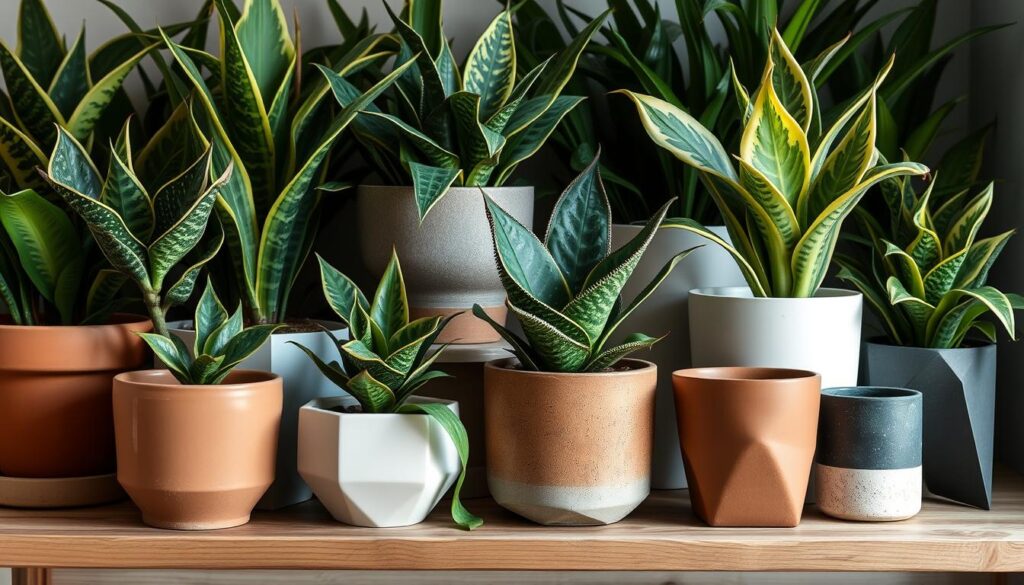
“Choosing the right container for your snake plant can make all the difference in maintaining its health and vibrance.”
Signs of Underwatering in Snake Plants
Snake plants (Dracaena trifasciata) are tough but need the right amount of water to grow well. If they don’t get enough water, they show signs of trouble. Spotting these signs early helps your snake plant recover and avoid more harm.
Visual Indicators
The common signs of underwatering in snake plants are:
- Brown, crispy leaf tips
- Drooping, curling, or wilting leaves
- Soil that is hard and pulling away from the pot’s edges
- Slowed or stunted growth
These signs mean the plant is not getting enough water and is struggling to stay healthy.
Treatment Solutions
If you see any of these signs, it’s time to act. Water the plant well, making sure the soil is fully moist. If the soil is too hard, you might need to repot it with new, draining mix.
Watch the plant closely for a few days. Adjust your watering as needed. Keep the soil moist but not too wet. With proper care, your snake plant will recover and grow strong again.
https://www.youtube.com/watch?v=dcTuqj3F2Lo
“Proper watering is essential for the long-term health and success of your snake plant.”
Identifying Overwatering Problems
Snake plants are known for being tough and easy to care for. But, they can still face problems from too much water. Signs of overwatering include yellow leaves, mushy stems, and waterlogged soil. Knowing these signs helps you care for your snake plants better.
Yellow, wilting, or droopy leaves are big clues of overwatering. The leaves might also feel soft and squishy. This shows the plant is struggling with too much moisture.
Soil that stays wet or waterlogged is another warning sign. It can lead to fungal growth and root rot. In bad cases, you might see white, fuzzy mold on the soil.
- Yellowing or drooping leaves
- Soft, mushy stems
- Waterlogged, constantly moist soil
- Presence of mold or fungus in the soil
- Foul, unpleasant odor from the soil
If you think your snake plant is overwatered, act fast. Start by taking it out of its pot and check the roots. Brown, mushy, or smelly roots mean root rot. You’ll need to cut out the bad roots and put the plant in new, draining soil.
| Symptom | Cause | Solution |
|---|---|---|
| Yellow, wilting leaves | Overwatering | Allow soil to dry out, reduce watering frequency |
| Soft, mushy stems | Overwatering, root rot | Inspect roots, remove affected portions, repot in well-draining soil |
| Waterlogged, moldy soil | Overwatering | Allow soil to dry out, improve drainage, repot if necessary |
By watching for signs of overwatering and fixing them fast, you can keep your snake plants healthy. The secret to good care is finding the right amount of water – not too much, not too little.
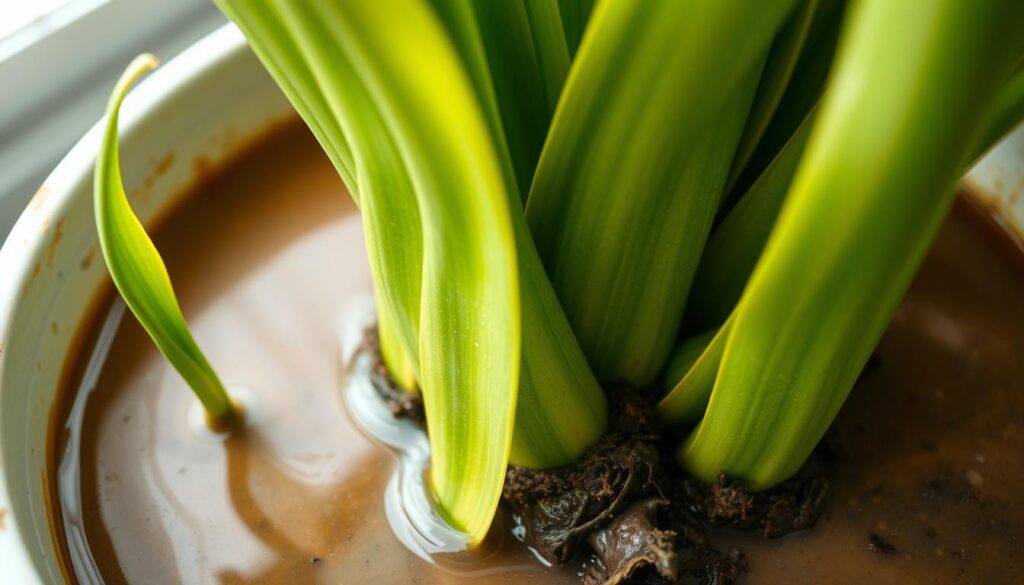
Best Practices for Watering Techniques
Proper watering is key for your snake plant’s health. These plants are easy to care for. To water your snake plant correctly, follow these tips.
Deep Watering Techniques
Water your snake plant deeply. Soak the soil until water drains from the bottom. This makes sure the roots get enough moisture.
Let the soil dry completely before watering again. This prevents too much water.
Utilizing Moisture Meters
Get a moisture meter for your succulents. It helps you know when to water. Use it before each watering to check the soil’s dryness.
“Nearly 80% of houseplant owners struggle with watering their plants properly, which is crucial for snake plants as well.”
By following these tips, your snake plant will thrive. Remember, the right amount of water is essential for these plants.
Seasonal Care and Maintenance Tips
The snake plant’s water needs change with the seasons. In spring and summer, water it every two weeks. Also, give it a diluted fertilizer monthly to help it grow well.
In fall and winter, water it once a month. This is because it grows slower in cooler weather. Keep watering this way until spring comes again.
Wipe the leaves with a damp cloth to remove dust. This helps the plant absorb light better and look vibrant. When the soil gets old, repot the plant in spring. Use a mix that’s good for succulents and cacti.
Don’t repot too often. Snake plants do best when their roots are a bit tight.
In cold months, keep your snake plant away from drafts and sudden temperature changes. These can stress the plant. By adjusting your care for the seasons, your snake plant will stay healthy and beautiful all year.
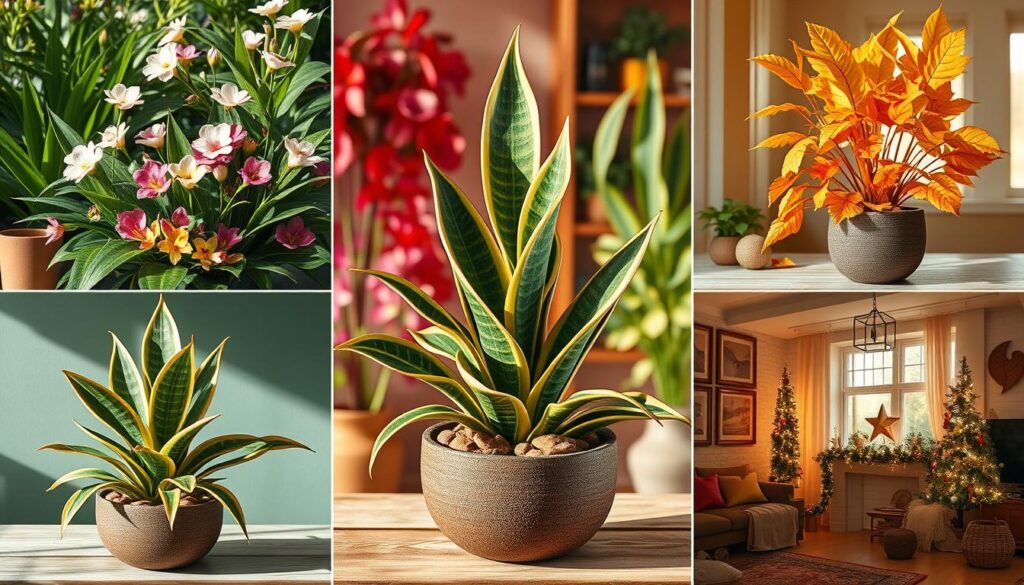
“Proper seasonal care is key to keeping your snake plant healthy and vibrant throughout the year.”
Common Watering Mistakes to Avoid
Caring for a snake plant seems easy, but even experts can make mistakes. These mistakes can harm these hardy plants. To keep your snake plant healthy, avoid a few key watering errors.
One big mistake is overwatering. Snake plants need water only every 2-3 weeks in the growing season. In winter, they need water every 4-6 weeks. Too much water can cause root rot, which is bad for the plant. Always check the soil moisture before watering, and only water when the top inch or two is dry.
Another mistake is inconsistent watering. Snake plants like a steady watering schedule. Changing how often you water can stress the plant. Keeping a regular watering routine, based on the season, helps your snake plant stay healthy.
- Avoid using containers without proper drainage holes, as this can lead to waterlogged soil and root rot.
- Be mindful of seasonal changes and adjust your watering schedule accordingly. Snake plants require less water during the winter months.
- Resist the temptation to mist the leaves, as this can promote fungal growth and increase the risk of disease.
Successful snake plant care is about listening to the plant’s needs. By avoiding these common mistakes, your snake plant will thrive for years.
“Overwatering is the number one killer of snake plants, so it’s crucial to be vigilant and only water when the soil is dry.”
Conclusion
Snake plants are loved for their toughness and easy care. To keep them happy, it’s important to know how often to water them. This knowledge helps your snake plant thrive with little effort.
These plants can handle being a bit dry, but too much water is bad. By watering right and avoiding mistakes, your snake plant will stay healthy. This way, you can enjoy its beauty and benefits for a long time.
Whether you’re new to plants or have lots of experience, knowing how to water snake plants is key. With the right care, you’ll enjoy their beauty and health benefits for years.
